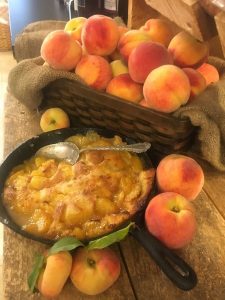Just Peachy
Just Peachy
Peach blossoms typically have five pink petals, but they are occasionally known to be white. Peaches are either freestones or clingstones, the difference being the flesh separating easily from the pit or not. Freestone peaches flesh is easily separated from the pit, while the other is not. Peaches have fuzzy skin. Peaches with smooth skin… Read More »

Peaches have fuzzy skin. Peaches with smooth skin are called nectarines and are typically regarded as a different fruit. Peach flesh can come in three different varieties, white, yellow, and red. Peaches are eaten fresh, baked in cobblers and pies, and canned peaches are enjoyed all around the world. We grow three different varieties of peaches, yellow, white and donut on approximately 30 acres of farmland. A popular, yet unusual type of peach is the donut peach, also known as the flat peach or Saturn peach. These peaches are flatter than other varieties and are typically sweeter than other peaches and are said to have almond undertones in taste. Peach season typically starts in late June, early July and continues through September with the proper weather conditions. Peaches are now available in our farm store, farm stands and farmers markets in areas near you.
Peaches were cultivated in New Jersey in the early 1600s when “colonists began importing European varieties.” Early settlers realized that the peach thrived better in the coastal regions of the United States than in Europe (A History of the New Jersey Peach, Rutgers). “An atlas published in Scotland in 1684 named New Jersey ‘The Garden of the World’ and by 1680, peaches were grown in abundance with extensive orchards from Trenton to New Brunswick before spreading north to Morristown and Hackettstown” (A History of the New Jersey Peach, Rutgers). The peach was the first fruit to “receive attention commercially” and by the mid 1800s New Jersey was known for its “abundance and quality of peaches.” Hunterdon County became the center of peach production in the late 1800s, shipping up to 750,000 bushels of peaches in a single season (A History of the New Jersey Peach, Rutgers).
Peach trees are unable to grow in extreme cold temperatures, and are unable to be grown in climates that regularly reach -10 to -15 degrees Fahrenheit. However, peach trees require a period of winter chilling. After this dormant period, they thrive. If the winters are mild and the trees are unable to remain dormant, they do not grow properly. However, late freezing temperatures that occur after the “dormant period” damage the crops and can cause significant crop loss.
Peach trees have a short life span, with the average lifespan approximately 12-15 years. We have some peach trees as old as fifteen years still
Our farm steward, Sam, shares his Grandma Tyson’s favorite recipe for peach season here. This recipe has been in Sam’s family for years and we are happy to share it with you. Traditionally served at breakfast time, Sam’s family enjoyed this wholesome meal before they went out and worked in their orchards. We hope you enjoy eating in season with this delicious and simple one dish recipe for Skillet Peach Pudding.
Best wishes from our farm kitchen to yours! XO







